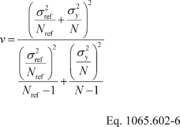§ 1065.602 Statistics.
(a) Overview. This section contains equations and example calculations for statistics that are specified in this part. In this section we use the letter “y” to denote a generic measured quantity, the superscript over-bar “–” to denote an arithmetic mean, and the subscript “ref” to denote the reference quantity being measured.
(b) Arithmetic mean. Calculate an arithmetic mean, y ~, as follows:

Example:

(c) Standard deviation. Calculate the standard deviation for a non-biased (e.g., N–1) sample, σ, as follows:

Example:

(d) Root mean square. Calculate a root mean square, rmsy, as follows:

Example:

(e) Accuracy. Determine accuracy as described in this paragraph (e). Make multiple measurements of a standard quantity to create a set of observed values, yi, and compare each observed value to the known value of the standard quantity. The standard quantity may have a single known value, such as a gas standard, or a set of known values of negligible range, such as a known applied pressure produced by a calibration device during repeated applications. The known value of the standard quantity is represented by yrefi. If you use a standard quantity with a single value, yrefi would be constant. Calculate an accuracy value as follows:

Example:

(f) t-test. Determine if your data passes a t-test by using the following equations and tables: (1) For an unpaired t-test, calculate the t statistic and its number of degrees of freedom, v, as follows:


Example: